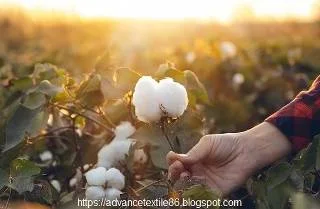Cotton fiber
Cotton
fiber is a soft, fluffy staple fiber that grows in a ball or protective case,
around the seeds of the cotton plant of the genus Gossypium of the Mallow
family Malvaceae. The fiber is almost pure cellulose and may contain a small
percentage of wax, fat, pectin, and water. Under natural conditions, cotton
balls will increase seed dispersal. Fiber is often spun into thread or yarn and
used to create a soft, breathable, and durable textile. The use of cotton for
cloth has been known since prehistoric times; Pieces of cotton cloth dating to
the 5th millennium BC have been found in the Indus Valley Civilization, as well
as remnants of 6000 BC cloth in Peru. Although cultivated since ancient times,
it was the invention of the cotton gin that reduced production costs that led
to its widespread use, and is the most widely used natural fiber fabric in
clothing today.
Cotton fiber properties
i.
Cotton fiber moisture regains 8%
ii.
Cellulose is arranged in such a way that it gives cotton the unique properties
of strength, durability, and absorption
iii.
It is fresh, crisp, comfortable, absorbent, flexible, has no peeling problem,
and is well resistant to alkali
iv.
It has poor wrinkle resistance, shrinkage, weak acid resistance, low abrasion
resistance, susceptibility to damage by insects and cracks, requires lots of
maintenance, and is hard to remove stains.
v.
Its fiber length ranges from 0.5 inches to 2 inches
vi.
When wet, its strength increases by 10%.
vii.
It has the shape of a flat-rolled tube
viii.
It can hold water 24–27 times their own weight
ix.
It is strong, dye absorbent, and can stand up against abrasion wear and high
temperature
x.
It can be blended with other fibers such as nylon, linen, wool, and polyester,
to achieve the best properties of each fiber.
Cotton fiber production process
i.
Cultivation
Most
of the farming is done in spring. The soil is made by removing the residue of
the previous crop cultivated in the soil. This is done by cutting the stalks
and inverting them on the ground or placing them on the ground to protect them
from erosion. In spring, the soil is sown with the help of special machines,
some of which make lines for planting seeds, others plant the seeds on flat
land because cotton requires high-fertility soil, so farmers add a lot of
fertilizer. Seeds, or near them, pesticides may be added during soil
preparation, or during cotton cultivation.
ii.
Cotton fiber harvesting
The
first step in cotton processing is harvesting and it is an important process
for farmers. This is the most important step before the completion of a few
months of planting and care, and before its identification journey begins from
the cotton gin to the mill. After the crop matures, the harvest begins. Early
harvesting can disrupt maturation, negatively affecting fiber quality while
waiting too long can lead to reduced fiber yield.
iii.
Cotton ginning process
After
the cotton is harvested, it is bale-pressed and sent to the cotton gin so that
the main part can be separated from the seed. In the ginning process, the
cotton goes through a group of cylinders working with centrifugal force, some
of which is used to dry the cotton from moisture, others to clean the cotton
from dust and strange substances, and then the cotton is pressed into the bell.
Will be transferred to a spinning, and weaving factory then to a dyeing and printing
factory. Seeds are sent to contemporaries to extract oil from them.
iv.
Spinning
In
the spinning process, the spinning machines take the cotton fiber from the
silver and rotate it up to 2500 revolutions in a second twist which turns the
fibers into yarn for weaving. Mills spin and twist the roving and place it on
the bobbin. Using automatic windings, the yarn bobbins are transferred to a
larger bobbin called a cheese cone.
Cotton fiber Advantages
i.
Cotton fiber is more comfortable than other fibers.
ii.
It is naturally sustainable fiber.
iii.
It supports farmers and communities.
iv.
You sleep better with cotton products.
v.
It is hypoallergenic.
vi.
It is odor-free.
vii.
It is low maintenance.
viii.
It isn't clingy.
ix.
It is versatile and inexpensive fiber
x.
It is high-tech
xi.
It is naturally absorbent and doesn't show perspiration like synthetics
xii.
It is easily biodegradable.
xiii.
It is solid, strong, durable, and resists scraped spot
Cotton fiber Disadvantages
i.
Cotton fiber fabric is not a very strong fabric.
ii.
It is heavy and takes a long time to dry, also stains easily.
iii.
It contains poor elasticity so creases badly.
iv.
It shrinks badly.
v.
It is highly flammable and burns quickly.
vi.
It is attacked by mildew if left damp.
vii.
Its color fades away easily
viii.
Its durability is low compared to synthetic fibers
Conclusion
Cotton
fiber is one of the most important raw materials in the textile industry and is
also a renewable natural resource. For this reason, cotton is widely grown in
the world. The growth and development stages of cotton consist of stages of
emergence, seedling, square, flowering, boll-setting, and boll-opening, which
last a total of 180-200 days. Cotton yield is formed through fruits. The basic
components of lint yield are the number of bolls per unit of land, weight per
boll, and lint percentage. The quality of cotton fiber can be mainly determined
by the length of the fiber, the strength of the fiber, and the fineness of the fiber. A wide range of factors such as environment, planting methods, agronomic
systems, and harvesting control every developmental process of the cotton
plant, both vegetative and reproductive growth, and also affect the yield and
quality of cotton fiber. Thus, in order to achieve maximum yield and quality of
cotton fiber, an appropriate combination of genotype, environmental conditions
and cultural practices like light and simplified culture should be adopted.









0 Comments